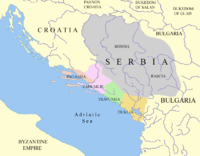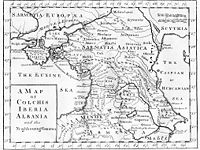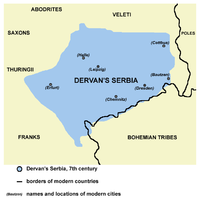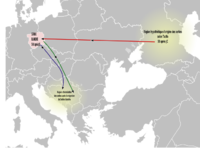- Origin of the Serbs
-
Serbs are a South Slavic people, living mainly in Serbia, Bosnia and Herzegovina and Montenegro. There are opinions that ethnonym Serbs possibly has a different root. Various researchers provided several theories about the origin of the Serb ethnonym and their opinions are based on the data from historical sources that mentioning Serb ethnonym or other Serb-sounding names in other parts of the Old World. However, the connection between modern Serbs in the Balkans and some early historical data related to Serb-sounding names remains largely unproved and controversial.
Contents
Early historical records of the Serb name
Various authors mentioned names of Serbs (Serbian: Srbi / Срби) and Sorbs (Upper Sorbian: Serbja; Lower Sorbian: Serby) in different variants: Surbii, Suurbi, Serbloi, Zeriuani, Sorabi, Surben, Sarbi, Serbii, Serboi, Zirbi, Surbi, Sorben, [1] etc. These authors used these names to refer to Serbs and Sorbs in areas where their historical (or current) presence was/is not disputed (notably in the Balkans and Lusatia), but there are also sources that mention same or similar names in other parts of the World (most notably in the Asiatic Sarmatia in the Caucasus). Attempts of various researchers to connect these names with modern Serbs produced various theories about the origin of the Serb people.
Early historical mentions of the Serb ethnonym in the Caucasus:
- Pliny the Younger in his work Plinii Caecilii Secundi Historia naturalis from the first century AD (69-75) mentioned people named Serbi,[2] who lived near the Cimmerians, presumably on the Black Sea and the Sea of Azov.
- In the 2nd century (around 175 AD), the Egyptian scientist Claudius Ptolemy mentioned in his Geography people named Serboi or Sirboi,[3] who presumably lived behind the Caucasus, near the hinterland of the Black Sea.
- In the 10th century, Byzantine emperor Constantine VII Porphyrogennetos (912-959) mentioned in his book De Ceremoniis two tribes named Krevatades (Krevatas) and Sarban (Sarbani), which some researches identified as Croats and Serbs. These tribes were located in the Caucasus near the river Terek, between Alania and Tsanaria. [4][5][6][7] The Sarban tribe in the Caucasus in the 10th century was also recorded by an Arab geographer.[8]
Early historical mentions of other Serb-sounding names that some researchers are trying to connect with the Serb people:
- In the same book where he mentioned people named Serboi, Claudius Ptolemy also mentioned city named Serbinum in Pannonia.[9]
- Ancient geographer Strabo mentioned that river Xanthos in Lycia was formerly named Sirbis.[10]
- Herodotus mentions lake named Serbonis in Egypt. This lake was also mentioned as Sirbonis by Strabo.[11]
Other Serb-sounding names
This is a list of Serb-sounding place names that some researchers are connecting with Serbs:[12]
- In Russia: Serbino, Serbi, Serbinovka, Sarbaka
- In Poland: Serbentinije, Serbentini, Serbinov, Sjerbovice, Sarbice, Sarbijevo, Sarbin
- In Lithuania: Serben, Serbigal
- Near the Baltic Sea: Sarbske
- On the Caucasus: Serab, Servičaj
- In Mesopotamia: Sorbatje, Serbis (river)
In Afghanistan and Pakistan there is a tribal group of Pashtuns called Sarbans / Sarbani. Their name is similar to the name of Caucasian tribe named Sarban (Sarbani), which some researchers connected to Serbs.[13]
Some researches are also trying to connect Serb name with other somewhat similar names such are Siberia (region in Russia),[14] Sibiru (island near Sumatra),[15] Seri or Sereri (ancient people in Central Asia)[16], Montes Serrorum (old name for Carpathians), Sarmatia (ancient region in Eastern Europe), Sirmium (city in ancient Pannonia), etc.
Aside from place names in Poland, whose part, together with Lusatia, is seen as area of historical White Serbia, there is no general scientific consensus that any of the mentioned names is related to modern Serbs.
Migration of Serbs to the Balkans
 Serb lands in the Balkans in the 9th century, mostly according to De Administrando Imperio.
Serb lands in the Balkans in the 9th century, mostly according to De Administrando Imperio.
According to the work named "De administrando imperio", written by the Byzantine emperor Constantine VII Porphyrogennetos (912-959), Balkanic Serbs originating from pagan White Serbs who lived on the other side of Turkey (name used for Hungary), in the area that they called Bojki. Neighbors of White Serbs were Frankish State and pagan Great or White Croatia. Porphyrogennetos claims that after two brothers inherited administration over Serbia (i.e. White Serbia) from their father, one of them, with half of the people, escaped to the Byzantine Empire (i.e. to the Balkans), which was governed by emperor Heraclius (610-641).[17][18][19] According to German historian L. A. Gebhardi, two brothers that inherited administration over White Serbia were sons of prince Dervan.[20]
In the Balkans, Serbs settled around rivers Tara, Ibar, Drina and Lim (in the present-day border region of Serbia, Montenegro and Bosnia and Herzegovina), and joined with surrounding South Slavic tribes that came to the Balkans earlier (in the 6th century), together with the Avars. Over time, these tribes also adopted Serb name as their own.[21]
Another part of the White Serbs did not migrated southwards, but remained in the Elbe region. Descendants of these White Serbs are the present day Lusatian Serbs (Sorbs), who still live in the Lusatia (Lužica, Lausitz) region of eastern Germany.
There are also opinions that data from "De administrando imperio" that describes Serb migration to the Balkans is not correct and that Serbs came to the Balkans from Eastern Slavic lands, together with other South Slavs.[22][23]
The Emperor Constantine III (641) transferred a part of the Slavs from the Balkans (Vardar region) to Asia Minor. There these migrants founded the city of Gordoservon, the name of which gives grounds for supposing that among its founders there were Serbs.[24] The city was also known under names Gordoserbon and Servochoria.
Various theories about origin of the Serbs
The Iranian theory
Theory about Iranian origin of the Serb ethnonym assumes that ancient Serbi / Serboi from north Caucasus (Asiatic Sarmatia) were an Sarmatian (Alanian) tribe.[25] The theory subsequently assumes that Alanian Serbi were subdued by the Huns in the 4th century and that they, as part of the Hunnic army, migrated to the western edge of the Hunnic Empire (in the area of Central Europe near the river Elbe, later designated as White Serbia in what is now Saxony (eastern Germany) and western Poland). After Hunnic leader Attila died (in 453), Alanian Serbi presumably became independent and ruled in the east of the river Saale (in modern day Germany) over local Slavic population.[26][27] Over time, they, it is argued, intermarried with the local Slavic population of the region,[28][29] adopted Slavic language, and transferred their name to the Slavs.[30] According to Tadeuš Sulimirski, similar event could occur in the Balkans or Serbs who settled in the Balkans were Slavs who came from the north and who were ruled by already slavicized Alans.[31]
Deformed human sculls that are connected to the Alans are also discovered in the area that was later designated as "White Serbia".[32] According to Iranian interpretation, different sides of the World are designated with different colors, thus, white color is designation for the west, black color for the north, blue or green color for the east and red color for the south. According to that view, White Serbia and White Croatia were designated as western Serbia and western Croatia, and were situated in the west from some hypothetical lands that had same names and that presumably existed in the east.[33]
It is possible that the Alanian Serbi in Sarmatia, similarly like other Sarmatian/Iranian peoples on the northern Caucasus, originally spoke an Indo-European Iranian language similar to present-day Ossetian. The Ossetian language is a member of Eastern Iranian branch of Iranian languages, along with Pashtun, Yaghnobi and languages of the Pamir. One of the Pashtun tribal groups in Afghanistan and Pakistan is known as Sarbans (Sarbani) and Pashtuns are believed to be of partial Scythian descent[34] (Sarmatian language is also grouped within Scythian branch).
In Polish history, the Polish nobility claimed to be direct descendants of the historic Sarmatian people (see: Sarmatism) and this might be connected with historical White Serbia and White Croatia, which included parts of present-day Poland.
The Caucasian theory
According to some interpretations, Serb ethnonym might be of Caucasian or more notably of Lezgian origin. In the Lezgian language, "ser" would mean "man", while "serbi" would mean "men" or "people".[35]
The Autochthonic theory
This theory assumes that Serbs are an autochthonic people in the Balkans and Podunavlje, where they presumably lived before historical Slavic and Serb migration to the Balkans in the 6th-7th centuries.[36] Proponents of this theory (for example Đura Daničić, Pavel Jozef Šafárik) claimed that Serbs either came to the Balkans long before the 7th century or Serb 7th century migration to the Balkans was only partial and Serbs who, according to "De administrando imperio", came from the north founded in the Balkans other Serbs that already lived there.[37] It is suggested that ancient city of Serbinum in Pannonia was named after these hypothetical autochthonic Serbs.[38]
Although, modern anthropology and genetics are confirming that present-day Balkanic Serbs are partial descendants of slavicized autochthonic Balkanic peoples (Illyrians, Vlachs, etc), there is no generally accepted scientific evidence that ancient inhabitants of the Balkans were Serbs or Slavs.
The Serbo-Slavic theory
In the mid-9th century the so called Bavarian Geographer wrote that people named Zeriuani had so large kingdom that all Slavic peoples originated from there (or from them).[39] [40][41] According to one of interpretations, Zeriuani are identified with Serbs, and there are opinions that "Serbs" was an old name of all Slavic peoples.[42] However, according to other opinions, Zeriuani might be a name used for Severians or Sarmatians instead for Serbs.[43]
The Indian theory
There are several authors (for example Miloš S. Milojević, Draško Šćekić), who supported theory that Serbs originating from India. The sole evidence that supporting this theory is an old Serbian folk song named "Sveci blago dijele" ("The saints dividing the treasure"), whose one stanza says: "kad ja idem iz zemlje Inđije" ("when I went from the land of India").[44]
References
- ^ Živko D. Petković, Prve pojave srpskog imena, Beograd, 1996, page 9.
- ^ Aleksandar M. Petrović, Arheografija naroda jugoistočne Evrope, Beograd, 2006, page 19.
- ^ Aleksandar M. Petrović, Arheografija naroda jugoistočne Evrope, Beograd, 2006, page 19.
- ^ De administrando imperio, Constantine VII Porphyrogenitus (Emperor of the East), Gyula Moravcsik, Pázmány Péter Tudományegyetemi Görög Filológiai Intézet, 1949, page 115.
- ^ Parameśa Caudhurī, India in Kurdistan, Qwality Book Company, 2005, page 79.
- ^ The Slavs: their early history and civilization, Francis Dvornik, American Academy of Arts and Sciences, 1959, page 28.
- ^ Constantini Porphyrogenneti... libri duo De ceremoniis aulæ Byzantinæ. Prodeunt nunc primum Græce, cum Latina interpretatione et commentariis. Curarunt Io. Henricus Leichius et Io. Iacobus Reiskius..., VII Constantin, Gleditschius, 1754, page 397.
- ^ The early medieval Balkans: a critical survey from the sixth to the late twelfth century, John Van Antwerp Fine, University of Michigan Press, 1991, page 56.
- ^ Aleksandar M. Petrović, Arheografija naroda jugoistočne Evrope, Beograd, 2006, page 19.
- ^ Aleksandar M. Petrović, Arheografija naroda jugoistočne Evrope, Beograd, 2006, page 20.
- ^ Živko D. Petković, Prve pojave srpskog imena, Beograd, 1996, pages 18-19.
- ^ Živko D. Petković, Prve pojave srpskog imena, Beograd, 1996, pages 8, 11, 12, 43, 46.
- ^ Parameśa Caudhurī, India in Kurdistan, Qwality Book Company, 2005, page 79.
- ^ Živko D. Petković, Prve pojave srpskog imena, Beograd, 1996, page 5.
- ^ Živko D. Petković, Prve pojave srpskog imena, Beograd, 1996, page 5.
- ^ Živko D. Petković, Prve pojave srpskog imena, Beograd, 1996, page 25.
- ^ Sava S. Vujić - Bogdan M. Basarić, Severni Srbi (ne)zaboravljeni narod, Beograd, 1998, pages 38-39.
- ^ Aleksandar M. Petrović, Kratka arheografija Srba, Novi Sad, 1994, pages 90-91.
- ^ Vladimir Ćorović, Ilustrovana istorija Srba, knjiga prva, Beograd, 2005, page 61.
- ^ Sava S. Vujić - Bogdan M. Basarić, Severni Srbi (ne)zaboravljeni narod, Beograd, 1998, page 40.
- ^ Sava S. Vujić - Bogdan M. Basarić, Severni Srbi (ne)zaboravljeni narod, Beograd, 1998, page 36.
- ^ Relja Novaković, Još o poreklu Srba, Beograd, 1992, page 57.
- ^ Nikola Jeremić, Srpska zemlja Bojka, Zemun, 1993, page 33.
- ^ The Macedonian question: the struggle for southern Serbia, Đoko M. Slijepčević, American Institute for Balkan Affairs, 1958, page 50.
- ^ Miodrag Milanović, Srpski stari vek, Beograd, 2008, page 81.
- ^ Relja Novaković, Još o poreklu Srba, Beograd, 1992, page 46.
- ^ Miodrag Milanović, Srpski stari vek, Beograd, 2008, page 81.
- ^ Relja Novaković, Još o poreklu Srba, Beograd, 1992, page 46.
- ^ Miodrag Milanović, Srpski stari vek, Beograd, 2008, page 81.
- ^ Relja Novaković, Još o poreklu Srba, Beograd, 1992, page 48.
- ^ Relja Novaković, Još o poreklu Srba, Beograd, 1992, page 46.
- ^ Relja Novaković, Još o poreklu Srba, Beograd, 1992, page 48.
- ^ Relja Novaković, Srbi, Zemun, 1993, page 61.
- ^ Martial races of undivided India, Vidya Prakash Tyagi, Gyan Publishing House, 2009, page 122.
- ^ Sava S. Vujić - Bogdan M. Basarić, Severni Srbi (ne)zaboravljeni narod, Beograd, 1998, page 33.
- ^ Aleksandar M. Petrović, Kratka arheografija Srba, Novi Sad, 1994, pages 9-10.
- ^ Aleksandar M. Petrović, Kratka arheografija Srba, Novi Sad, 1994, page 10.
- ^ Aleksandar M. Petrović, Kratka arheografija Srba, Novi Sad, 1994, page 8.
- ^ Lazo M. Kostić, O srpskom imenu, Srbinje - Novi Sad, 2000, pages 38-39.
- ^ Aleksandar M. Petrović, Kratka arheografija Srba, Novi Sad, 1994, page 90.
- ^ Quaestiones medii aevi, Томови 1-4, Uniwersytet Warszawski. Instytut Historyczny, Polskie Towarzystwo Historyczne. Commission d'histoire médiévale, Éditions de l'Université de Varsovie, 1977, page 31.
- ^ Lazo M. Kostić, O srpskom imenu, Srbinje - Novi Sad, 2000, pages 38-39.
- ^ Prosvjeta, Том 16, Društvo hrvatskih književnika., 1908, page 216.
- ^ Draško Šćekić, Sorabi, Beograd - Podgorica, 1994, page 22.
Further reading
- Aleksandar M. Petrović, Kratka arheografija Srba, Novi Sad, 1994.
- Živko D. Petković, Prve pojave srpskog imena, Beograd, 1996.
- Lazar Šebek, Stari Srbi, Serbi sveske 2, Izdavač: Krim, Beograd, Ložionička 4.
- Lazo M. Kostić, O srpskom imenu, Srbinje - Novi Sad, 2000.
- Sava S. Vujić - Bogdan M. Basarić, Severni Srbi (ne)zaboravljeni narod, Beograd, 1998.
- Nikola Jeremić, Srpska zemlja Bojka, Zemun, 1993.
- Relja Novaković, Baltički Sloveni u Beogradu i Srbiji, Beograd, 1985.
- Relja Novaković, Još o poreklu Srba, Beograd, 1992.
- Relja Novaković, Srbi, Beograd, 1993.
- Relja Novaković, Srbi i njihovi pradavni srodnici, Beograd, 2000.
- Ernst Schwartz, Das Vordringen der Slawen nach Western, Südost-Forschungen, Band XV, Mönchen 1956
- Ernestus Brotuff, Chronica von den Salz-Bornen und Erbauung der Hall an der Sala... (Weiland J.J. 1554) in zwei Büchern Verfaset und Fleiss beschrieben. Hall in Sachsen 1679
- Franz Martin Pelzels Geschichte der Böhmen, von ältesten bis auf die neuesten Zeiten. Aus den besten einheimischen und auswärtigen Geschichtsschreibern, Kroniken und gleichzeitigen Handschriften zusammen getragen, Erster Theil, Vierte fortgesetzte Auflage, Prag 1817
- Franz Grabler. Aus dem Geschichtswerk des Laonikos Chalkokondilos. Europa im XV. Jahrhundert von Byzantinern gesehen. Byzantinische Geschichtsschreiber, Graz-Wien-Köln (1954)
- Friderici Wideburgii, Origines et antiquitates Marggraviatus Misnici... Halae Salicae 1734
- Franc. Xav. El. B. De Pejacsevich, Historia Serviae seu colloquia XIII de Statu Regni et religionis Serviae ab exordio ad finem, sive a saeculo VII ad XV. Auetore F.X. El. B. de Pejacsevich. Colocae MDCCXCVI (1796)
- Howorth. The Spread of the Slaves, The Journal of the Antropological Institute of Great Britain and Ireland, vol. IX, London 1880, Part III The Northern Serbs or Sorabiens and the Obodriti
- Martin Kromer, De origine et rebus gestis Polonorum Iibri XXX (1555)
- Mauro Orbini, II regno De gli Slavi Hoggi corrottamente detti Schü-voni... In Pesaro MDCI (1601)
- Monumenta Germaniae Historica... Edidit G.H. Pertz. Tomus I-VI 1826-1844
- Nikolaus Volrab, Chronica von den Antiquiteten des Keisrlichen Stiftes/der Römische Burg und Stadt Marseburg... (Budišin 1556)
- Neuve Chronica Türkischer Nation von Türken selbst beschrieben Frankfurt am Mayn 1590
- Pomponii Melae de Chorographia Iibri tres recognovit Caroli;:- Fnck. Lipsiae 1880
- P.J. Schafariks, Slawische Alterthümer, II, Leipzig 1844
- Heinrich Kunstmann, Über die Herkunft der Polen von Balkan. Die Welt der Slawen, Halbsjahresschrift für Slavistik, Jahrgang XXIX, Heft 2, IV F. VIII, 2. München 1984
- Hana Skalovä, Topografickä mapa üzemi Obodricü a Veletu-Luticu ve svetle mistnfch Jmen. Vznik a pocätky Slovanü. Pracha 1965
- Joan Christopori de Jordan... De originibus Slavicis... Vindobonae MDCCXLV (1745)
- Joannes Simoni Vandalia a 1598. scripta. Mon. Ren germ, praecipue Cimbricarum et Megapolensium... T. I, Lipsiae 1739
- Joannis Bacmeisteri... Animadversiones Genealogico-Chronologico-hi-storico in Mareschalci Thurii Annalium Herulorum et Vandalorum Hbros septem. У збирци: Mon. ined. R.G. praecipue Cimbricarum, et Megapolensium... erui... Ernestus Joachim de Westphalen... Tomus I, Lipisae 1739
- Johann Georg Essigs Kurze Einleitung zu der allgemeinen und besonderen Welthistorie, aufs neue übersehen, vermehrt, und bis auf gegenwärtige Zeit fortgesetzte, von M. Johann Christian Walz, Prof. der Historie am Her-zogl. Gimnasio. Zehnte Ausgabe, Stuttgart 1777
- Karl Gottlob Anton, Erste Linien eines Versuches über die alten Slawen Ursprung, Sitten, Gebräuche, Meinungen und Kenntnisse. Ausgearbeitet von K.G. Anton, D. Leipzig 1783
- Karl Gottlob Anton, Geschichte der Teutschen Nazion, Erster Theil... Geschichte der Germanen, Leipzig 1793
- Karl Penka, Origines Ariacae, Linguistisch-ethnologische Untersuchungen zur ältesten Geschichte der arischer Völker und Sprache. Wien und Te-schen 1883
- Laskaris Kananos, Die Nordlandreise des Laskaris Kanons (Byz. Geschichtsschreiber)
- Ludwig Giesebrecht, Wendische Geschichten von der Karolingerzeit, Baltische Studien, Sechsten Jahrgang, Zweites Heft, Stettin 1839
- Lubomir E. Havlik, Einige Fragen der Ethnogcnese der Slawen im Lichte der römischen und byzantinischer Historiographie (1. Hälfte des 1. Jahrtausends), Berichte II (1970), Band III, Berlin 1973
- Blondi Flavii Foroiuliensis Historiarum de inclinatione Romanorum. Impressarum Venetiis Thomam Alexandrinum anno Salutis MCCCCLXXXiiii (1484) Kalendis Julii. Tu i Abreviatio Pii Pont max. supra decades Blondi ab Inclinatione Imperii usque ad tempora Joannis Vicesimi tertii Pont. max.
- Chronica von dem Antiquiteten des Stifftes/der Romische Burg und Stadt Marseburg/an der Salach by Türingen/mit viel alten schöne Historien und Geschichten/als sich etwan vor alten Zeiten in Sachsen/Türingen/Meis-sen/und zu Wenden begeben... Gedruckt zu Budisin durch Nicolaum Wolrab MDLVI (1556)
- Chronicon HoIIandiae de Hollandorum Repub. et Rebus Gestis com-mentarii Hugonis Grolii, Jani Dovsae patris, Jani Dovsae filii, Lugduni Ba-tavorum 1617
- Conjectus introduetionis, in notitiam Regni Hungriae Geographicam, Historicam, Politicam et Chronologicam, inde a prima Gentis et Regionis Hungaricae Originibus usque ad aetatem nostram. Breviter et succinte, per successions temporum, produetam Studio et Opera Joannis Tomka Szäszky, Posonii 1759
- Caroli Sigoni Histriarum de Occidentali imperio, libri XX... Cum Indice copiosissime rerum et Verborum, Basileae MDLXXIX (1579)
- Christophori Cellarii Smalkandcnsis Geographia Antiqua... 1687
- Chronici Zelandiae libri duo. Auetore Jacobo Eyndio. Domino Haem-stode et Midolburgi. Ex officino moulertiana MDCXXXIV (1634)
- Codex Pomeraniae diplomaticus. Herausgegeben von D. Karl Friedrich Wilhelm Hasselbach... und D. Johann Gottfried Ludwig Kosegarten, Greifswald 1862
- Chronicon Mundi (Correct Title): Regisrum huius operis libri chroni-corum cum figuris et imaginibus ab initio mundi. Norimbergae MCCCCXCIII (1493)
- Chronici Carionis a Philippo Melanthone aueti et expositi... (1532). Anno 1581, 1593 [Wittebergae] MOXCIII (1593)
- Cyriacus M. Spangenberg, Quenfurtische Chronica. Historischer Bericht, von der Aelten und Loblichen Herrschaft Quernfurt in Sachsen... vor und nach der Geburt Christi... In vier Bücher zusammengebracht durch M. Cyr. Spang. MDXC (1590)
- Dauidis Chytrej Chronicon Saxoniae et vicini orbis aretoi. Pars prima. Ab anno Christi 1500 usque ad 1524 cum indice. Rostochii anno CIDIDXCII (1592)
- Dissertatio de Lecho et Slavorum origine video meliora, proboque. Acta Societatis Jablonovianae de Slavis Lecho Czechoque. Item de Veris Zichis. Anni CIDIDCCLXXI (1771)
- C. Desjardins: Physisch-Statistisch und Politischer Atlas von Europa, C. Desjardins, Wien, 1838.
- Über die Abkunft der Slawen nach Lorenz Surowiecki von Paul Joseph Schaffarik, Doct. der Phil. und der f. k. Mag., Prof. am Gymnasium der Griech. n. un. Gemeinde in Neusatz, und der kön. Ges. der Freunde der Wiss. in Warschau, der Gel. Ges. an der Univ. in Krakau und der Gross-herz. lat. Soc. in Jena corr. Mitgliede. Leipzig, 1843
- Kiepert's Handatlas, Dietrich Reimer, Berlin, 1860.
- A. Stieler: Handatlas, Justus Perthes, Gotha, 1866
- Kiepert's Atlas Antiques, Geographisches Institut, Weimar, 1884
- Nikodim Milaš: Православна Далмација (Ortodox Dalmatia), Izdavačka knjižarnica Novi Sad, 1901
- Кonstantin Jeriček: Историја Срба (History of Serbs), I-II, (photoiphya), Слово љубве, Београд, 1978
- Early references to Serboi: Alexander Kazhdan, Oxford Dictionary of Byzantium (1991), vol.3, pp.1875f.
- Ivo Vukcevich: Rex Germanorum Populos Sclavorum (An Inquiry into the Origin and Early History of the Serbs/Slavs of Sarmatia, Germania and Illyria), Universiyu Center Press, Santa Barbara, 2001
- Aleksandar J. Vukosavljević: Neka zapažanja o 30. glavi De administrando imperio — analiza izvora i osvrt na jedan dio istoriografije, Cape Town, 2004
See also
- White Serbs
- Serboi
- Serbs
- Sorbs
- Serbia
- History of Serbs
- History of Serbia
- Theories on the origin of Croats
- Prehistoric Balkans
Categories:- History of the Serbs
- Origin hypotheses of ethnic groups
Wikimedia Foundation. 2010.






